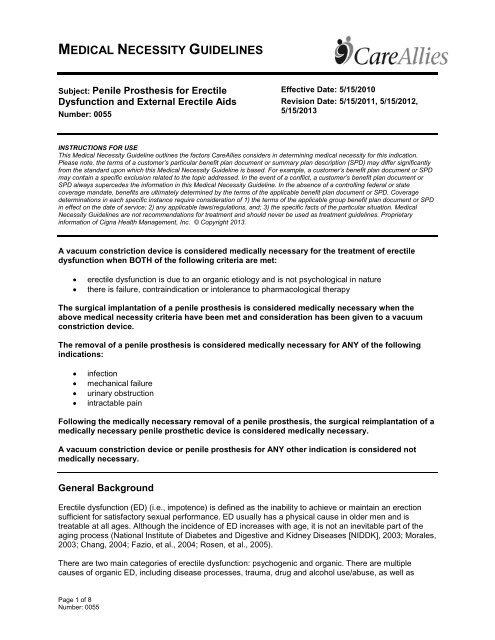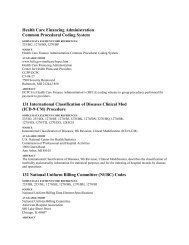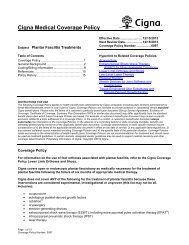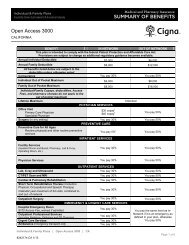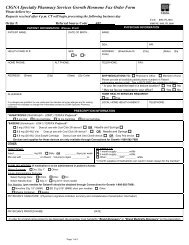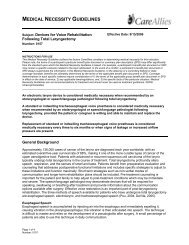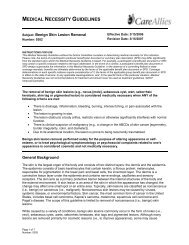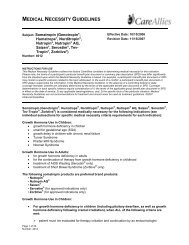Penile Prosthesis for Erectile Dysfunction and External ... - Cigna
Penile Prosthesis for Erectile Dysfunction and External ... - Cigna
Penile Prosthesis for Erectile Dysfunction and External ... - Cigna
Create successful ePaper yourself
Turn your PDF publications into a flip-book with our unique Google optimized e-Paper software.
MEDICAL NECESSITY GUIDELINES<br />
Subject: <strong>Penile</strong> <strong>Prosthesis</strong> <strong>for</strong> <strong>Erectile</strong><br />
<strong>Dysfunction</strong> <strong>and</strong> <strong>External</strong> <strong>Erectile</strong> Aids<br />
Number: 0055<br />
Effective Date: 5/15/2010<br />
Revision Date: 5/15/2011, 5/15/2012,<br />
5/15/2013<br />
INSTRUCTIONS FOR USE<br />
This Medical Necessity Guideline outlines the factors CareAllies considers in determining medical necessity <strong>for</strong> this indication.<br />
Please note, the terms of a customer’s particular benefit plan document or summary plan description (SPD) may differ significantly<br />
from the st<strong>and</strong>ard upon which this Medical Necessity Guideline is based. For example, a customer’s benefit plan document or SPD<br />
may contain a specific exclusion related to the topic addressed. In the event of a conflict, a customer’s benefit plan document or<br />
SPD always supercedes the in<strong>for</strong>mation in this Medical Necessity Guideline. In the absence of a controlling federal or state<br />
coverage m<strong>and</strong>ate, benefits are ultimately determined by the terms of the applicable benefit plan document or SPD. Coverage<br />
determinations in each specific instance require consideration of 1) the terms of the applicable group benefit plan document or SPD<br />
in effect on the date of service; 2) any applicable laws/regulations, <strong>and</strong>; 3) the specific facts of the particular situation. Medical<br />
Necessity Guidelines are not recommendations <strong>for</strong> treatment <strong>and</strong> should never be used as treatment guidelines. Proprietary<br />
in<strong>for</strong>mation of <strong>Cigna</strong> Health Management, Inc. © Copyright 2013.<br />
A vacuum constriction device is considered medically necessary <strong>for</strong> the treatment of erectile<br />
dysfunction when BOTH of the following criteria are met:<br />
• erectile dysfunction is due to an organic etiology <strong>and</strong> is not psychological in nature<br />
• there is failure, contraindication or intolerance to pharmacological therapy<br />
The surgical implantation of a penile prosthesis is considered medically necessary when the<br />
above medical necessity criteria have been met <strong>and</strong> consideration has been given to a vacuum<br />
constriction device.<br />
The removal of a penile prosthesis is considered medically necessary <strong>for</strong> ANY of the following<br />
indications:<br />
• infection<br />
• mechanical failure<br />
• urinary obstruction<br />
• intractable pain<br />
Following the medically necessary removal of a penile prosthesis, the surgical reimplantation of a<br />
medically necessary penile prosthetic device is considered medically necessary.<br />
A vacuum constriction device or penile prosthesis <strong>for</strong> ANY other indication is considered not<br />
medically necessary.<br />
General Background<br />
<strong>Erectile</strong> dysfunction (ED) (i.e., impotence) is defined as the inability to achieve or maintain an erection<br />
sufficient <strong>for</strong> satisfactory sexual per<strong>for</strong>mance. ED usually has a physical cause in older men <strong>and</strong> is<br />
treatable at all ages. Although the incidence of ED increases with age, it is not an inevitable part of the<br />
aging process (National Institute of Diabetes <strong>and</strong> Digestive <strong>and</strong> Kidney Diseases [NIDDK], 2003; Morales,<br />
2003; Chang, 2004; Fazio, et al., 2004; Rosen, et al., 2005).<br />
There are two main categories of erectile dysfunction: psychogenic <strong>and</strong> organic. There are multiple<br />
causes of organic ED, including disease processes, trauma, drug <strong>and</strong> alcohol use/abuse, as well as<br />
Page 1 of 8<br />
Number: 0055
smoking. ED may occur as a result of an underlying medical condition, such as diabetes, kidney disease,<br />
hormonal imbalance, multiple sclerosis, atherosclerosis, vascular disease or neurological disease. Injury<br />
to the penis, spinal cord, prostate, bladder, <strong>and</strong> pelvis may also cause ED due to damage to nerves<br />
smooth muscles, arteries or fibrous tissue of the corpora cavernosa. Surgery, especially radical prostate<br />
or bladder surgery can injure the nerves <strong>and</strong> arteries near the penis resulting in ED. One of the side<br />
effects of medications, such as antihypertensive drugs, antihistamines, antidepressants, tranquilizers,<br />
histamine-receptor antagonists <strong>for</strong> treatment of gastric ulcers, opiates, <strong>and</strong> appetite suppressants is ED.<br />
Peyronie’s disease, which causes scarring of the fibrous tissue of the penis, <strong>and</strong> priapism (i.e., persistent,<br />
abnormal erection of the penis) are associated with ED. Other possible contributing factors of ED include<br />
smoking, which affects blood flow, <strong>and</strong> hormonal abnormalities. Psychological factors (e.g., stress,<br />
anxiety, depression, <strong>and</strong> low self-esteem) cause 10–20% of ED cases (NIDDK, 2003; Morales, 2003;<br />
Chang, 2004; Rosen, et al., 2005; McVary, 2007).<br />
The most important component of diagnosing ED is obtaining a complete medical <strong>and</strong> psychosexual<br />
history. A psychogenic disorder can be the primary cause of ED; there<strong>for</strong>e, early recognition <strong>and</strong><br />
appropriate referral <strong>for</strong> counseling may be recommended. Concurrent medical illnesses <strong>and</strong> medications<br />
should be reviewed. The history may reveal reversible or modifiable risk factors, such as inadequate<br />
diabetes control. The physical examination should focus on the vascular, neurological <strong>and</strong> endocrine<br />
systems. Laboratory investigations should follow clinical suspicion of specific disorders. The First<br />
International Consultation on <strong>Erectile</strong> <strong>Dysfunction</strong>, cosponsored by the World Health Organization<br />
(WHO), the International Consultation on Urological Diseases, <strong>and</strong> the Societé Internationale d’Urologie,<br />
recommends obtaining a fasting glucose or glycosylated hemoglobin level, a lipid profile <strong>and</strong> a<br />
testosterone assay. Testing <strong>for</strong> prostate-specific antigen (PSA) level was not recommended by this<br />
international consultation; however, it would be in accordance with American Urological Association<br />
(AUA) <strong>and</strong> American College of Surgeons (ACS) guidelines (Broderick, et al., 2002; Fazio, et al., 2004;<br />
Baldo, et al., 2005; McVary, 2007).<br />
The method of treatment <strong>for</strong> ED is dependent upon the etiology of the condition. Psychologically-based<br />
ED, without organic cause (e.g., secondary to depression, anxiety, stress) may dissipate with<br />
psychotherapy <strong>and</strong>/or behavioral therapy. According to the American Urological Association (AUA), the<br />
management of ED begins with the identification of organic comorbidities <strong>and</strong> psychosexual dysfunctions;<br />
both should be appropriately treated. Organic ED can occur as a secondary condition to several diseases<br />
<strong>and</strong>/or their treatment. Treatment of underlying diseases such as diabetes mellitus, hypertension, heart<br />
disease <strong>and</strong> endocrine conditions (e.g., hypogonadism, hyperprolactinemia, <strong>and</strong> thyroid disorders), <strong>and</strong><br />
cessation or modification of prescription medications (e.g., antihypertensives) may be indicated.<br />
Discontinuing alcohol consumption <strong>and</strong> illicit drug use, <strong>and</strong>/or making lifestyle modifications (e.g.,<br />
avoiding smoking, maintaining ideal body weight <strong>and</strong> engaging in regular exercise) may reverse ED.<br />
Treatment of Peyronie’s disease resulting in severe curvature may involve the concomitant use of<br />
incision/grafting <strong>and</strong> prosthesis insertion due to the significant incidence of erectile dysfunction following<br />
surgery on the penis <strong>for</strong> Peyronie’s plaques (Taylor <strong>and</strong> Levine, 2007). There is some controversy<br />
regarding testosterone replacement therapy, which includes oral preparations, intramuscular injections,<br />
topical gels, <strong>and</strong> transdermal preparations. Topical gels are the most commonly prescribed <strong>for</strong>ms of<br />
testosterone replacement (NIDDK, 2003; Morales, 2003; Chang, 2004; Seftel, et al., 2004; Brant, et al.,<br />
2007; McVary, 2007).<br />
Therapy should be applied in a “stepwise fashion with increasing invasiveness <strong>and</strong> risk balanced against<br />
the likelihood of efficacy” (American Urological Association [AUA], 2006). Oral agents (e.g., PDE-5<br />
inhibitors) have become the first-line treatment option <strong>for</strong> ED. Use of PDE-5 inhibitors is successful in 70–<br />
80% of men. With the availability of oral agents <strong>and</strong> minimally invasive options surgical implantation<br />
typically occurs when these less invasive options are unavailable, unsuccessful or provide inadequate<br />
erective function (NIDDK, 2003; Morales, 2003; Fazio, et al., 2004; Carson, 2005; Jain <strong>and</strong> Terry, 2006;<br />
Brant, et al., 2007; McVary, 2007; Sadeghi-Nejad, 2007).<br />
U.S. Food <strong>and</strong> Drug Administration (FDA)<br />
There are two types of mechanical devices <strong>for</strong> treatment of erectile dysfunction: vacuum constriction<br />
devices <strong>and</strong> implantable penile prosthetic devices. Both are regulated by the FDA. Vacuum constriction<br />
devices are classified by the FDA as Class II medical devices <strong>and</strong> are exempt from the premarket<br />
notification requirements of the 510(k) process (NIDDK, 2003; FDA, 2004). Examples of these devices<br />
Page 2 of 8<br />
Number: 0055
are the Rejoyn Vacuum Therapy System (American Med Tech, Dodge City, KS) <strong>and</strong> Osbon ErecAid <br />
Vacuum Therapy (Endocare, Inc., Eden Praire, MN).<br />
Implantable penile prostheses are either noninflatable (i.e., semirigid rods) or inflatable. Noninflatable<br />
devices are classified by the FDA as Class II medical devices <strong>and</strong> consist of a pair of semi-rigid rods or<br />
cylinders that are surgically implanted in the corpora cavernosa. The purpose of the device is to provide<br />
adequate penile rigidity <strong>for</strong> intercourse. This classification includes the following designs (FDA, 2000):<br />
• rod prosthesis: a flexible, solid cylinder of polymer material<br />
• malleable prosthesis: a flexible polymer cylinder that incorporates an internal metal core<br />
• single-hinged prosthesis: a highly flexible material that enables the user to position the penis<br />
downward <strong>for</strong> concealment<br />
• multiple-hinged prosthesis: a series of hinged segments, encapsulated in a polymer sheath<br />
The AMS Malleable 650 (American Medical Systems, Inc., Minnetonka, MN) <strong>and</strong> the Mentor Genesis <br />
<strong>Penile</strong> <strong>Prosthesis</strong> (Mentor Corporation, Santa Barbara, CA) are examples of rigid penile prostheses.<br />
Inflatable devices are classified by the FDA as Class III medical devices <strong>and</strong> consist of paired cylinders,<br />
surgically implanted inside the penis, which can be exp<strong>and</strong>ed using pressurized fluid. Tubes connect the<br />
cylinders to a reservoir filled with radiopaque fluid implanted in the abdomen <strong>and</strong> a subcutaneous pump<br />
implanted in the scrotum. The user inflates the cylinders by pressing on the small pump, located under<br />
the skin in the scrotum (FDA, 2004; NIDDK, 2003). The AMS 700 CXM (American Medical Systems, Inc.,<br />
Minnetonka, MN) <strong>and</strong> the Mentor Alpha 1 ® (Mentor Corporation, Santa Barbara, CA) are examples of<br />
inflatable penile prostheses.<br />
Vacuum Constriction Device<br />
When medical modalities are unsuccessful or contraindicated, a vacuum constriction device offers a<br />
viable alternative treatment. This device functions as an external aid; however, some users may find it<br />
difficult to use. The device causes an erection by creating a partial vacuum, drawing blood into the penis,<br />
engorging <strong>and</strong> exp<strong>and</strong>ing it. The device has three components: a plastic cylinder, in which the penis is<br />
placed; a pump that draws air out of the cylinder; <strong>and</strong> an elastic b<strong>and</strong> that is placed around the base of<br />
the penis to maintain the erection when the cylinder is removed.<br />
<strong>Penile</strong> <strong>Prosthesis</strong><br />
When nonsurgical therapies have proven ineffective, a penile prosthesis may be surgically implanted.<br />
Since surgery destroys the corpus cavernosus of the penis, this procedure precludes any future<br />
pharmacological treatment (NIH, 1992; NIDDK, 2003; Morales, 2003).<br />
Complications of penile prostheses include erosion of the device, mechanical failure <strong>and</strong> the possibility of<br />
infection. Device extrusion, migration, urinary obstruction <strong>and</strong> prolonged or intractable pain are other<br />
potential risks. The average infection rate post-operatively ranges from 2–4% over a two year period, with<br />
most infections becoming evident during the first year. Some bacterial species can lie indolent <strong>for</strong> as long<br />
as two years be<strong>for</strong>e causing clinical signs of infection. Men with diabetes, spinal cord injuries or urinary<br />
tract infections have an increased risk of prosthesis-associated infections. If the infection cannot be<br />
successfully treated with antibiotics, it may be necessary to remove the prosthesis. Replacement with a<br />
new prosthesis should be delayed after removal of an infected prosthesis to allow adequate healing <strong>and</strong><br />
eradication of the offending microorganism (NIH, 1993; FDA, 2004; Chang, 2004).<br />
Literature Review<br />
Due to the nature of these devices, outcomes reported in studies evaluating their effectiveness are largely<br />
self-reported <strong>and</strong> subjective (e.g., patient satisfaction questionnaires). Objective outcome measures that<br />
have been reported in the medical literature include rate of mechanical failures <strong>and</strong> defects, <strong>and</strong><br />
complications. Published evidence supports improved patient satisfaction with the use of penile implants<br />
when compared to sildenafil or intracavernous injections (Rajpurkar, et al., 2003); improved quality of life<br />
(Ferguson, et al., 2003); <strong>and</strong> improved erectile function (Mulhall, et al., 2003). Patient satisfaction has<br />
been reported to range from 71% to 91.2% with the use of implantable penile prostheses (Ferguson, et<br />
al., 2003; Minervini, et al., 2005; Israilov, et al., 2005; Zermann, et al., 2005; Knoll, et al., 2009; Paranhos,<br />
Page 3 of 8<br />
Number: 0055
et al., 2010). Wilson et al. (2007) reported an estimated mechanical revision rate of 79.4% <strong>for</strong> device<br />
survival at 10 years compared to 71.2% at 15 years. The authors also noted with newer devices a 10-<br />
year mechanical survival <strong>and</strong> freedom from mechanical breakage increased to 88.6% <strong>and</strong> 97.9%,<br />
respectively. In general, the medical literature indicates these devices are safe <strong>and</strong> effective <strong>for</strong> the<br />
treatment of ED <strong>for</strong> a carefully selected subset of individuals whose condition is organic in nature <strong>and</strong><br />
have failed more conservative treatment.<br />
Professional Societies/Organizations<br />
In May of 2006 the AUA published guidelines <strong>for</strong> the management of erectile dysfunction (AUA, 2006).<br />
According to the guidelines, the following therapies are considered st<strong>and</strong>ard treatment <strong>for</strong> ED: oral<br />
phosphodiesterase type 5 (PDE-5) inhibitors, intra-urethral alprostadil, intracavernous vasoactive drug<br />
injection, vacuum constriction devices, <strong>and</strong> penile prosthesis implantation (AUA, 2006).<br />
The American Association of Clinical Endocrinologists (AACE) <strong>and</strong> American College of Endocrinology<br />
(ACE) issued a guideline on the evaluation <strong>and</strong> treatment of male sexual dysfunction. The guideline<br />
supports the use of vacuum constriction pumps <strong>and</strong> internal implanted penile prostheses in the treatment<br />
of ED (AACE, 2003).<br />
Summary<br />
Evidence in the peer-reviewed, published scientific literature, including published guidelines from<br />
professional societies <strong>and</strong> organizations, indicate vacuum constriction devices <strong>and</strong> penile prostheses are<br />
considered a safe <strong>and</strong> effective treatment option <strong>for</strong> the treatment of erectile dysfunction in a carefully<br />
selected subset of individuals whose condition is due to an organic etiology <strong>and</strong> in whom more<br />
conservative treatment has failed.<br />
Coding/Billing In<strong>for</strong>mation<br />
Note: 1) This list of codes may not be all-inclusive.<br />
Vacuum Constriction Device<br />
When medically necessary:<br />
HCPCS<br />
Codes<br />
L7900<br />
L7902<br />
Description<br />
Male vacuum erection system<br />
Tension ring, <strong>for</strong> vacuum erection device, any type, replacement only, each<br />
<strong>Penile</strong> <strong>Prosthesis</strong><br />
When medically necessary:<br />
CPT ® * Description<br />
Codes<br />
54400 Insertion of penile prosthesis; noninflatable (semi-rigid) ROI 38.1<br />
54401 Insertion of penile prosthesis; inflatable (self-contained) ROI 11634<br />
54405 Insertion of multi-component inflatable penile prosthesis, including placement of<br />
pump, cylinders <strong>and</strong> reservoir ROI 86.9<br />
HCPCS<br />
Codes<br />
C1813<br />
C2622<br />
Description<br />
<strong>Prosthesis</strong>, penile, inflatable<br />
<strong>Prosthesis</strong>, penile, noninflatable<br />
<strong>Penile</strong> <strong>Prosthesis</strong> Removal<br />
Page 4 of 8<br />
Number: 0055
When medically necessary:<br />
CPT ® * Description<br />
Codes<br />
54406 Removal of all components of a multi-component, inflatable penile prosthesis<br />
without replacement of prosthesis<br />
54408 Repair of component(s) of a multi-component, inflatable penile prosthesis<br />
54410 Removal <strong>and</strong> replacement of all component(s) of a multi-component, inflatable<br />
penile prosthesis at the same operative session<br />
54411 Removal <strong>and</strong> replacement of all components of a multi-component inflatable<br />
penile prosthesis through an infected field at the same operative session,<br />
including irrigation <strong>and</strong> debridement of infected tissue<br />
54415 Removal of noninflatable (semi-rigid) or inflatable (self-contained) penile<br />
prosthesis, without replacement of prosthesis<br />
54416 Removal <strong>and</strong> replacement of noninflatable (semi-rigid) or inflatable (selfcontained)<br />
penile prosthesis at the same operative session<br />
54417 Removal <strong>and</strong> replacement of noninflatable (semi-rigid) or inflatable (selfcontained)<br />
penile prosthesis through an infected field at the same operative<br />
session, including irrigation <strong>and</strong> debridement of infected tissue<br />
*Current Procedural Terminology (CPT ® ) © 2012 American Medical Association: Chicago, IL.<br />
References<br />
1. Abouassaly R, Angermeier KW, Montague DK. Risk of infection with an antibiotic coated penile<br />
prosthesis at device replacement <strong>for</strong> mechanical failure. J Urol. 2006 Dec;176(6 Pt 1):2471-3.<br />
2. American Association of Clinical Endocrinologists (AACE) Male Sexual <strong>Dysfunction</strong> Task Force.<br />
American Association of Clinical Endocrinologists medical guidelines <strong>for</strong> clinical practice <strong>for</strong> the<br />
evaluation <strong>and</strong> treatment of male sexual dysfunction: a couple’s problem—2003 update. Endocr<br />
Pract. 2003 Jan-Feb;9(1):77-95.<br />
3. American Urological Association (AUA). The management of erectile dysfunction: an update.<br />
2005. Updated 2006. Reviewed <strong>and</strong> validity confirmed 2011. Accessed March 18, 2013. Available<br />
at URL address: http://www.auanet.org/content/guidelines-<strong>and</strong>-quality-care/clinical-guidelines.cfm<br />
4. American Urological Association (AUA). <strong>Penile</strong> prostheses <strong>for</strong> erectile dysfunction [adult<br />
conditions: sexual function <strong>and</strong> infertility]. Reviewed January 2010. Accessed March 18, 2013.<br />
Available at URL address: http://www.auanet.org/content/guidelines-<strong>and</strong>-quality-care/clinicalguidelines/main-reports/edmgmt/content.pdf<br />
5. Baldo O, Eardley I. Diagnosis <strong>and</strong> investigation of men with erectile dysfunction. J Men’s Health<br />
Gend. 2005;2(1).<br />
6. Brant WO, Bella AJ, Lue TF. Treatment options <strong>for</strong> erectile dysfunction. Endocrinol Metab Clin<br />
North Am. 2007 Jun;36(2):465-79.<br />
7. Brinkman MJ, Henry GD, Wilson SK, Delk JR 2nd, Denny GA, Young M, Cleves MA.. A survey of<br />
patients with inflatable penile prostheses <strong>for</strong> satisfaction. J Urol. 2005 Jul;174(1):253-7.<br />
8. Broderick GA, Lue TF. Evaluation <strong>and</strong> nonsurgical management of erectile dysfunction <strong>and</strong><br />
priapism. In: Walsh PC, Retik AB, Vaughan ED Jr, Wein AJ, editors. Campbell’s urology. 8 th ed.<br />
Philadelphia, PA: W.B. Saunders Company; 2002. p. 1619-61.<br />
Page 5 of 8<br />
Number: 0055
9. Carson CC. Efficacy of antibiotic impregnation of inflatable penile prosthesis in decreasing<br />
infection in original implants. J Urol. 2004 Apr;171:1611-4.<br />
10. Carson CC. <strong>Penile</strong> prosthesis implantation: surgical implants in the era of oral medication. Urol<br />
Clin North Am. 2005 Nov;32(4):503-9, vii.<br />
11. Carson CC 3rd, Mulcahy JJ, Harsch MR. Long-Term Infection Outcomes After Original Antibiotic<br />
Impregnated Inflatable <strong>Penile</strong> <strong>Prosthesis</strong> Implants: Up to 7.7 Years of Followup. J Urol. 2011<br />
Feb;185(2):614-8.<br />
12. Chang YJ, Santucci RA. <strong>Penile</strong> prosthesis implantation. Updated Sept 2004 Accessed April 13,<br />
2005. Available at URL address: http://www.emedicine.com/med/topic3047.htm<br />
13. Fathy A, Shamloul R, AbdelRahim A, Zeidan A, El-Dakhly R, Ghanem H. Experience with Tube<br />
(Promedon) malleable penile implant. Urol Int. 2007;79(3):244-7.<br />
14. Fazio L, Brock G. <strong>Erectile</strong> dysfunction: management update. Can Med Assoc J. 2004<br />
Apr 27:170(9).<br />
15. Ferguson KH, Cespedes RD. Prospective long-term results <strong>and</strong> quality-of-life assessment after<br />
Dura-II penile prosthesis placement. Urol. 2003;61:437-41.<br />
16. Garaffa G, Li C. Moncada I, Ralph D. Surgical management of erectile dysfunction. Arch Esp<br />
Urol. 2010 Oct;63(8):728-38<br />
17. Hatzimouratidis K, Amar E, Eardley I, Giuliano F, Hatzichristou D, Montorsi F, Vardi Y, Wespes E.<br />
Guidelines on Male Sexual <strong>Dysfunction</strong>: <strong>Erectile</strong> <strong>Dysfunction</strong> <strong>and</strong> Premature Ejaculation. Eur<br />
Urol. 2010 Feb 20.<br />
18. Hellstrom WJ, Montague DK, Moncada I, Carson C, Minhas S, Faria G, Krishnamurti S. Implants,<br />
mechanical devices, <strong>and</strong> vascular surgery <strong>for</strong> erectile dysfunction. J Sex Med. 2010 Jan;7(1 Pt<br />
2):501-23.<br />
19. Israilov S, Shmuely J, Niv E, Engelstein D, Livne P, Boniel J. Evaluation of a progressive<br />
treatment program <strong>for</strong> erectile dysfunction in patients with diabetes mellitus. Int J Impot Res. 2005<br />
Sep-Oct;17(5):431-6.<br />
20. Jain S, Terry TR. <strong>Penile</strong> prosthetic surgery <strong>and</strong> its role in the treatment of end-stage erectile<br />
dysfunction - an update. Ann R Coll Surg Engl. 2006 Jul;88(4):343-8.<br />
21. Knoll LD, Henry G, Culkin D, Ohl DA, Otheguy J, Shabsigh R, Wilson SK, Delk Ii J. Physician <strong>and</strong><br />
patient satisfaction with the new AMS 700 momentary squeeze inflatable penile prosthesis. J Sex<br />
Med. 2009 Jun;6(6):1773-8.<br />
22. Lightfoot AJ, Rosevear HM, Kreder KJ. Inflatable penile prostheses: an update. Curr Opin Urol.<br />
2010 Nov;20(6):459-64.<br />
23. McVary KT. Clinical practice. <strong>Erectile</strong> dysfunction. N Engl J Med. 2007 Dec 13;357(24):2472-81.<br />
24. Menard J, Tremeaux JC, Faix A, Pierrevelcin J, Staerman F. <strong>Erectile</strong> function <strong>and</strong> sexual<br />
satisfaction be<strong>for</strong>e <strong>and</strong> after penile prosthesis implantation in radical prostatectomy patients: a<br />
comparison with patients with vasculogenic erectile dysfunction. Sex Med. 2011 Dec;8(12):3479-<br />
86. doi: 10.1111/j.1743-6109.2011.02466.x.<br />
25. Minervini A, Ralph DJ, Pryor JP. Outcome of penile prosthesis implantation <strong>for</strong> treating erectile<br />
dysfunction: experience with 504 procedures. BJU Int. 2006 Jan;97(1):129-33.<br />
Page 6 of 8<br />
Number: 0055
26. Montague DK. <strong>Penile</strong> prosthesis implantation in the era of medical treatment <strong>for</strong> erectile<br />
dysfunction. Urol Clin North Am. 2011 May;38(2):217-25.<br />
27. Montague DK, Barada JH, Belker AM, Levine LA, Nadig PW, Sharlip ID, et al. (American<br />
Urological Association [AUA] <strong>Erectile</strong> <strong>Dysfunction</strong> Clinical Guidelines Panel). Report on the<br />
treatment of organic erectile dysfunction [clinical practice guideline]. Approved 1996 Jul. Updated<br />
May 2006. Accessed March 18, 2013. Available at URL address:<br />
http://guidelines.gov/content.aspx?id=10018&search=organic+erectile+dysfunction<br />
28. Morales A. <strong>Erectile</strong> dysfunction: an overview. Clin Geriatr Med. 2003 Aug;19(3).<br />
29. Mulhall JP, Ahmed A, Branch J, Parker M. Serial assessment of efficacy <strong>and</strong> satisfaction profiles<br />
following penile prosthesis surgery. J Urol. 2003;169:1429-33.<br />
30. Mulhall J, Althof SE, Brock GB, Goldstein I, Jünemann KP, Kirby M. <strong>Erectile</strong> dysfunction:<br />
monitoring response to treatment in clinical practice--recommendations of an international study<br />
panel. J Sex Med. 2007 Mar;4(2):448-64. Erratum in: J Sex Med. 2007 May;4(3):825.<br />
31. National Institutes of Health (NIH). Impotence [NIH consensus statement]. 1992 Dec 7-<br />
9;10(4):1-31.<br />
32. National Kidney <strong>and</strong> Urologic Diseases In<strong>for</strong>mation Clearinghouse (NKUDIC). <strong>Erectile</strong><br />
dysfunction. 2003 Dec. Updated march 28, 2012. Accessed March 18, 2013. Available at URL<br />
address: http://kidney.niddk.nih.gov/kudiseases/pubs/ED/index.aspx<br />
33. Pahlajani G, Raina R, Jones S, Ali M, Zippe C. Vacuum Erection Devices Revisited: Its Emerging<br />
Role in the Treatment of <strong>Erectile</strong> <strong>Dysfunction</strong> <strong>and</strong> Early <strong>Penile</strong> Rehabilitation Following Prostate<br />
Cancer Therapy. J Sex Med. 2010 Nov 3. doi: 10.1111/j.1743-6109.2010.01881.x. [Epub ahead<br />
of print).<br />
34. Paranhos M, Andrade E, Antunes AA, Barbieri AL, Claro JA, Srougi M. <strong>Penile</strong> prosthesis<br />
implantation in an academic institution in Latin America. Int Braz J Urol. 2010 Sep-Oct;36(5):591-<br />
601.<br />
35. Rajpurkar A, Dhabuwala CB. Comparison of satisfaction rates <strong>and</strong> erectile function in patients<br />
treated with sildenafil, intracavernous prostagl<strong>and</strong>in E1 <strong>and</strong> penile implant surgery <strong>for</strong> erectile<br />
dysfunction in urology practice. J Urol. 2003 Jul;170:159-63.<br />
36. Rosen RC, Wing R, Schneider S, Gendrano N 3rd. Epidemiology of erectile dysfunction: the role<br />
of medical comorbidities <strong>and</strong> lifestyle factors. Urol Clin North Am. 2005 Nov;32(4):403-17, v.<br />
37. Sadeghi-Nejad H. <strong>Penile</strong> prosthesis surgery: a review of prosthetic devices <strong>and</strong> associated<br />
complications. J Sex Med. 2007 Mar;4(2):296-309.<br />
38. Santucci RA. <strong>Penile</strong> prosthesis implantation. Updated Jan 23, 2012. Accessed March 18, 2013.<br />
Available at URL address: http://www.emedicine.com/med/topic3047.htm<br />
39. Seftel AD, Mohammed MA, Althof SE. <strong>Erectile</strong> dysfunction: etiology, evaluation, <strong>and</strong> treatment<br />
options. Med Clin North Am. 2004 Mar;88(2).<br />
40. Stephenson RA, Mori M, Hsieh YC, Beer TM, Stan<strong>for</strong>d JL, Gillil<strong>and</strong> FD, Hoffman RM, Potosky<br />
AL. Treatment of erectile dysfunction following therapy <strong>for</strong> clinically localized prostate cancer:<br />
patient reported use <strong>and</strong> outcomes from the Surveillance, Epidemiology, <strong>and</strong> End Results<br />
Prostate Cancer Outcomes Study. J Urol. 2005 Aug;174(2):646-50; discussion 650.<br />
41. Taylor FL, Levine LA. Peyronie’s Disease. Urol Clin N Am. 2007 Nov; 34(4):517-34.<br />
Page 7 of 8<br />
Number: 0055
42. United States Food <strong>and</strong> Drug Administration (FDA). Class II special controls guidance document:<br />
external penile rigidity devices. Dec 28, 2004. Accessed March 18, 2013. Available at URL<br />
address:<br />
http://www.fda.gov/MedicalDevices/DeviceRegulation<strong>and</strong>Guidance/GuidanceDocuments/ucm072<br />
098.htm<br />
43. United States Food <strong>and</strong> Drug Administration (FDA). Guidance <strong>for</strong> the content of premarket<br />
notifications <strong>for</strong> penile rigidity implants. Jan 16, 2000. Accessed March 18, 2013. Available at<br />
URL address:<br />
http://www.fda.gov/MedicalDevices/DeviceRegulation<strong>and</strong>Guidance/GuidanceDocuments/ucm073<br />
769.htm<br />
44. University of Ottawa Evidence-based Practice Center, Ottawa Canada. Investigators:<br />
Tsertsvadze A, Yazdi F, Fink H, MacDonald R, Wilt T, Soares-Weiser K, et al. Diagnosis <strong>and</strong><br />
Treatment of <strong>Erectile</strong> <strong>Dysfunction</strong>. Publication No. 08(09)-E016). Agency <strong>for</strong> Healthcare<br />
Research <strong>and</strong> Quality (AHRQ). May 2009. Accessed March 18, 2013. Available at URL address:<br />
http://www.ncbi.nlm.nih.gov/bookshelf/br.fcgi?book=hserta&part=B163619<br />
45. Wilson SK, Delk JR, Salem EA, Cleves MA. Long-term survival of inflatable penile prostheses:<br />
single surgical group experience with 2,384 first-time implants spanning two decades. J Sex Med.<br />
2007 Jul;4(4 Pt 1):1074-9.<br />
46. Wilt TJ, Fink HA, MacDonald R, Rutks IR, Schow D. Treatment options <strong>for</strong> male erectile<br />
dysfunction: a systematic review of published studies of effectiveness. Updated 2001. Cochrane<br />
Database of Abstracts of Reviews of Effectiveness. In: The Cochrane Library, Vol. 1. Chichester,<br />
UK: John Wiley & Sons, Ltd.; 2005.<br />
47. X-Plain erectile dysfunction. Reference summary. Patient Education Institute, U.S. National<br />
Library of Medicine, National Institutes of Health (NIH). Accessed March 18, 2013. Available at<br />
URL address:<br />
http://www.nlm.nih.gov/medlineplus/tutorials/erectiledysfunctionyourchoices/htm/index.htm<br />
48. Xuan XJ, Wang DH, Sun P, Mei H. Outcome of implanting penile prosthesis <strong>for</strong> treating erectile<br />
dysfunction: experience with 42 cases. Asian J Androl. 2007 Sep;9(5):716-9.<br />
49. Zermann DH, Kutzenberger J, Sauerwein D, Schubert J, Loeffler U. <strong>Penile</strong> prosthetic surgery in<br />
neurologically impaired patients: long-term followup. J Urol. 2006 Mar;175(3 Pt 1):1041-4;<br />
discussion 1044.<br />
Page 8 of 8<br />
Number: 0055


